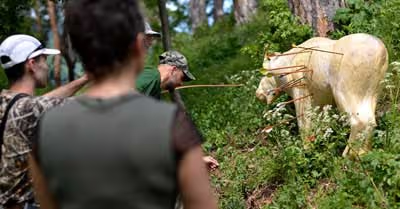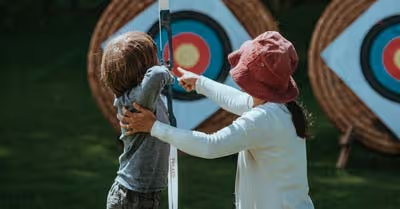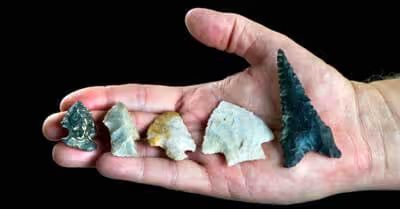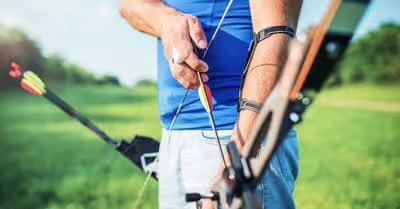Table of Contents
Does archery hurt?
The most common injuries people suffer when shooting targets are not injuries from arrow hits, which are rare, but from overstraining their bodies. While most people that regularly practice or compete with bows do not get hurt, archery carries the same risks as other strenuous physical activities.
Target archery is less dangerous than most sports. Soccer players risk colliding with other players; hockey and football are undoubtedly risky. Target archery is much safer as you are not running around and risking collisions.
How rare is it for someone to get hit by an arrow?
Few people get hit by arrows. Archery ranges have rules and will kick people out if they blatantly ignore safety precautions. Usually, this is enough to prevent people from getting hit entirely - most ranges have never had this type of injury.
Even in golf, more injuries are reported than in archery, so it easily qualifies as a safe sport. People are not likely to get hit by arrows. More injuries are reported when hunters aren't careful handling sharp broadhead arrows.
How to avoid pulled muscles and other less serious injuries
Since archery is safer than most sports, even small injuries are not frequently reported. However, you can hurt yourself if you use an improper shooting technique, ignore muscle fatigue, and shoot without safety equipment.
If you know about the most common ways to get hurt in archery, you can avoid them. There are potential injuries specific to archers and other injuries that people in many other sports get.
String slap
Newer and sometimes more experienced archers can get hurt if their bowstrings slap against their arms. This hurts more than a little and can lead to swelling and redness.
The easiest way out of this is to wear safety equipment. Use an armguard even if you are no longer new to archery.
If you do not wear an armguard, you can use the right stance to avoid these injuries. If you stand with a straight posture and use proper shooting form, you are less likely to hit your wrist or forearm.
Don't grip the bow any tighter than necessary, as that can put your arm in the string's way. You are also more likely to suffer a string slap if you are tired and shooting with a powerful bow that takes effort to pull back.
The string can also hit your chest when you pull it back. This can also give you welts and bruises even if the string is not hitting exposed skin. Wear a chest guard, which protects your chest from the string and also prevents the bowstring from getting caught in your clothing.
Injuries from handing arrows
If you hunt with a bow, you need to use sharp broadhead arrows that can cut you if you aren't careful. One of the easiest ways to hurt yourself is to tighten a broadhead onto an arrow entirely by hand. Use a broadhead wrench that keeps the blades away from your hands.
Use a covered quiver to protect yourself. Broadheads are very sharp, and they can cut you suddenly and unexpectedly if you don't use the right precautions. Hunters sometimes get cut when they are getting broadhead arrows out of a truck or dressing an animal that still has a sharp arrowhead in it.
Repetitive stress/strain injuries
You can get a repetitive strain injury from using a muscle over and over again the same way. You do not have to do very heavy and strenuous tasks to get a repetitive strain injury.
Even if the bow you use is easy for you to pull, you could still develop pain over time. At worst, you can end up with a chronic injury that will keep you out of the sport for a long time.
You are more likely to injure yourself in this way if you keep shooting after you are already feeling sore. Ignoring milder soreness may lead to worse and longer-lasting pain later on. Take breaks and avoid shooting a bow if your muscles have not yet recovered.
Finger blisters
You can also end up with blisters on your fingers pulling a bowstring, especially if you are new to the sport. You can reduce this problem by using proper shooting technique.
Shoot with your fingers on the right part of the string, or there will be too much friction. Raising your elbow too high when drawing a bow will also put too much friction on your fingers. Proper form is the only way to avoid blisters.
Rotator cuff injuries
This is another injury that may sneak up on you gradually. Your rotator cuff is a part of your shoulder that you use every time you shoot a bow. If you frequently practice, especially without proper form, you can injure it.
Your shoulder will ache, your arm will not have much strength or range of motion, and your shoulder will be too sore to put weight on while sleeping. Proper form can prevent this problem.
Make sure that you use your back muscles when you shoot to avoid overusing the rotator cuff. As always, don't shoot if your muscles hurt. Pulling a bow should not be difficult - you might want to switch to a bow with a lower draw weight.
Tendonitis
Tendon injuries are common in many sports. Both "tennis elbow" and "archer's elbow" refer to the same injury. Tendonitis is inflammation of any tendon, with the elbow being a vulnerable spot in archery.
If you have a mild case of tendonitis in your elbow, your arm will not hurt unless you straighten it fully, in which case there will be some pain. You might also not feel any pain unless you are pulling a bow. If you have a more serious case, your arm will hurt even if you do not use it and are not holding it straight.
Take a break from archery until your tendons heal completely, and switch to a weaker bow. Remember that archery is about your accuracy, not how far you can shoot. It is not supposed to be hard to pull the bow you use.
You can also do exercises to strengthen your shoulder and your wrists. The stronger you are, the less likely you are to end up with tendonitis.
Frozen shoulder
Frozen shoulder is a longer-lasting injury that may take a year or three to heal. Don't let that scare you away from archery - the sport has a low rate of injuries - but be careful.
Some people end up with this problem if they overuse their arms after an injury or a medical procedure. If a doctor recommends that you take it easy, you should take their advice seriously. People hurt their muscles and tendons by ignoring discomfort and pain or ignoring a doctor's advice to take it easy.
At first, you will feel pain when you move your shoulder. Your range of movement will decrease over time until your shoulder becomes "frozen" and hard to use. Thankfully, the pain will usually decrease when your range of movement reaches a low point.
Over time, the range of movement will begin to improve until your shoulder is back to normal. While it takes a while for this injury to heal, it is only a temporary injury.
Stretching can prevent this problem. Stretch before physical activity to prevent injuries in archery and in sports in general. Some stretching exercises can also help you recover from this problem, even if it might not go away quickly.
Does combat archery hurt?
No, the sport is painless. The arrows have foam tips, and the players wear facemasks, so there is no pain when you get hit by an arrow.
Teams play combat archery with relatively weak bows that are not any stronger than they need to be for the sport. The weaker bow strength plus the arrows' foam tips make getting hit with an arrow entirely painless.
When someone occasionally gets hurt in combat archery, it is because of bumping into other players and falling, not because of the arrows.
Recent Articles
















